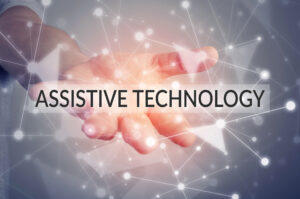
That’s one example of how assistive technology (AT) can improve learning experiences for students with disabilities. AT encompasses all systems, equipment and products that enhance the day-to-day lives of people with disabilities, according to the Assistive Technology Industry Association (ATIA). While this type of tech can have a huge impact in many realms of life, it has particularly notable potential to increase access to one of society’s most vital resources: education.
5 Examples of Assistive Tech for Students With Disabilities
There are many different kinds of AT that educators can integrate into classroom settings to accommodate students with disabilities. Here are just a few examples from the Understood article “8 examples of assistive technology and adaptive tools” and the Edutopia article “Easy Ways to Bring Assistive Technology Into Your Classroom.”
- Speech-to-text programs can help students with conditions that affect writing (e.g., dyslexia).
- Closed captioning for videos can assist children with hearing loss while also honing reading skills.
- FM systems (as mentioned earlier in this article) can reduce background noise for students with hearing loss or auditory processing issues.
- Graphic organizers and organizing programs can help children sort out their thoughts for assignments.
- Large display and talking calculators can assist students with math-related issues.
Why Access to Assistive Technology in Educational Settings Matters
During the 2019 to 2020 school year, 14 percent of all students attending public schools in the U.S. – amounting to 7.3 million pupils aged 3 to 21 – received special education services under the Individuals with Disabilities Education Act (IDEA), according to the National Center for Education Statistics.
That number has increased by approximately 12 percent since the 2009 to 2010 school year when 6.5 million public school students (13 percent of all public school enrollees) received special education services under IDEA.
To ensure education is attainable for all public school attendees, various federal regulations address access to assistive tech, according to the Early Childhood Technical Assistance Center. In addition to IDEA, the following laws support the use of AT to meet the needs of children with disabilities:
- The Assistive Technology Act (AT Act)
- Every Student Succeeds Act (ESSA)
- Americans with Disabilities Act (ADA)
AT can potentially make a big difference for the growing number of U.S. students with disabilities not only in school but also after high school graduation. For instance, a study titled “Assistive Technology and Students with High-Incidence Disabilities: Understanding the Relationship through the NLTS2” and published in the journal Remedial and Special Education analyzed data from the National Longitudinal Transition Study-2 and found that generally “students with high-incidence disabilities who reported receiving assistive technology in school had more positive postschool outcomes in terms of a paid job, wages, and participation in postsecondary education,” although receiving AT wasn’t a statistically significant predictor of positive post-school outcomes.
The pandemic and the shift to virtual learning illustrated the importance of efforts to improve accessibility for children with disabilities. Online education can be particularly challenging for students with disabilities, according to Pew Research Center. A 2016 survey of American adults (18 and up) found that members of this demographic aren’t as comfortable utilizing technology: 39 percent of those living with disabilities reported that possessing a high level of confidence in their ability to leverage the internet and other communication tools to stay informed describes them “very well,” compared to 65 percent of all American adults.
Even before COVID-19 spurred school shutdowns worldwide, technology had already transformed classrooms: The 2018 Global Education Census Report from Cambridge International found that 48 percent of students worldwide reported using a desktop computer at school, 42 percent used smartphones, and 20 percent utilized tablets.
Ultimately, as advanced technology becomes more prevalent in educational settings, it’s essential to take steps to ensure students with disabilities have an adequate level of access with tools like assistive tech. Otherwise, we risk leaving a significant portion of the population behind and missing out on their contributions to society.
If you’re interested in learning more about assistive tech in general, take a look at this blog entry: “The Benefits of Assistive Technology and How Innovation in the Tech World Can Help People Who Have Disabilities.”
For information about advanced and emerging technologies in general, feel free to reach out to our team by calling 877-599-3999 or emailing sales@stratospherenetworks.com.


